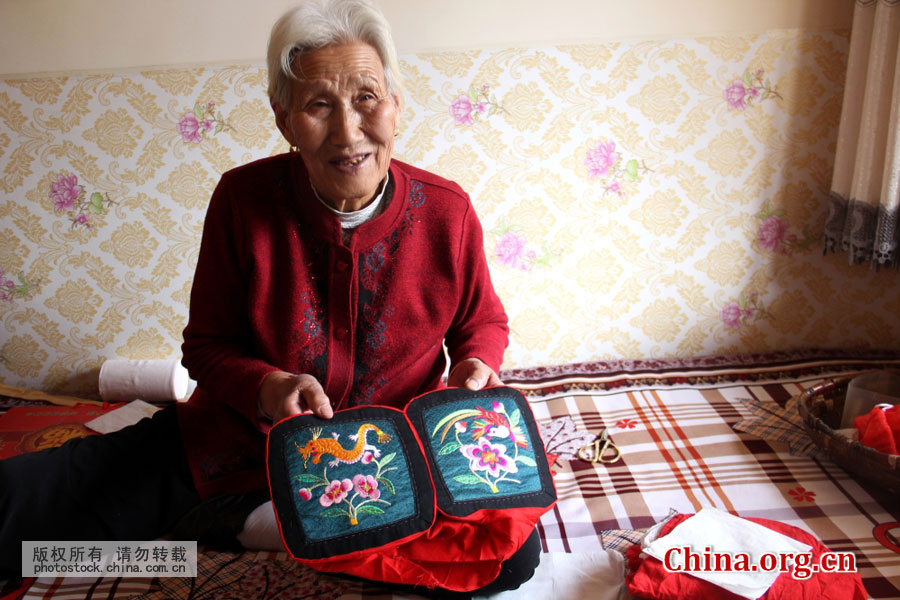An 83-year-old woman's pillow embroidery
- By Li Jingrong
 0 Comment(s)
0 Comment(s) Print
Print E-mail China.org.cn, April 14, 2016
E-mail China.org.cn, April 14, 2016
 |
|
Lyu Guizhen, 83, displays her pillow embroidery skills and patterns in Gaobao Village, Jingning County in Gansu Province, on April 10, 2016. [Photo by Guo Huimin/China.com.cn] |
Talented with her hands, 83-year-old Lyu Guizhen can do all sorts of pillow embroidery and has become known as a "master of embroidery" far and wide.
Lyu lives in Gaobao Village, Jingning County in Gansu Province. She started to learn embroidery from her mother at the age of eight and was able to embroider alone by the time she was 12.
Over a long period of time, Lyu has accumulated a wealth of embroidery experience. She is good at observing, creating and flexibly incorporating daily sights into her work. Her pillows have vivid patterns, bright colors, short and neat stitches and excellent craftsmanship. She has also been described as a "gardener in embroidery."
"Embroidery is very dear to me. The work brings both joy and entertainment," she explains. She has donated almost her entire output to relatives, friends and fellow villagers.
Due to its complicated craftsmanship, few young people these days like to fully engage in the study of this traditional handicraft or in the collection of pillow embroidery patterns. Lyu hopes that by publicly displaying her artworks she can help spread word of the traditional handicraft and that it will be inherited by more people and be better protected in the future.
More about embroidered pillows
Pillow embroidery is one of the traditional Chinese handicrafts. It began to develop and spread during the Qing Dynasty (1644-1911). In most cases, the pillows formed part of a girl's marriage dowry.
Great care and precision are needed, including sewing, stitching and embroidering. The basic materials are usually colorful cotton fabrics and silk threads. The pillows are usually divided into four categories -- square, flat, and tiger-headed pillows, and back cushions.
The designed patterns of pillow embroidery have strong local characteristics, including birds and beasts, flowers and plants, figures and landscapes. The patterns usually have a clear message and a profound moral in Chinese culture.
Here are some typical examples: the pattern of "dragon and phoenix" means extremely good fortune and prosperity; the pattern of a pair of mandarin ducks playing on water means an affectionate couple; and the pattern of blooming flowers and a full moon means perfect conjugal bliss for a newly married couple.
Due to the exquisite skills and abundant connotations, embroidered pillows have been well received by country folks and city dwellers alike, enjoying a huge market both at home and abroad. This traditional handicraft is included in the list of intangible Chinese cultural heritages.





Go to Forum >>0 Comment(s)